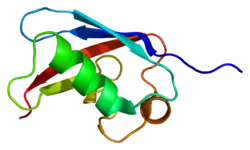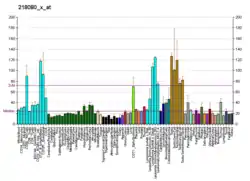FAF1
FAS-associated factor 1 is a protein that in humans is encoded by the FAF1 gene.[5][6]
Interaction of Fas ligand (TNFSF6) with the FAS antigen (TNFRSF6) mediates programmed cell death, also called apoptosis, in a number of organ systems. The protein encoded by this gene binds to FAS antigen and can initiate apoptosis or enhance apoptosis initiated through FAS antigen. Initiation of apoptosis by the protein encoded by this gene requires a ubiquitin-like domain but not the FAS-binding domain.[6]
References
- GRCh38: Ensembl release 89: ENSG00000185104 - Ensembl, May 2017
- GRCm38: Ensembl release 89: ENSMUSG00000010517 - Ensembl, May 2017
- "Human PubMed Reference:". National Center for Biotechnology Information, U.S. National Library of Medicine.
- "Mouse PubMed Reference:". National Center for Biotechnology Information, U.S. National Library of Medicine.
- Ryu SW, Chae SK, Lee KJ, Kim E (Oct 1999). "Identification and characterization of human Fas associated factor 1, hFAF1". Biochem Biophys Res Commun. 262 (2): 388–94. doi:10.1006/bbrc.1999.1217. PMID 10462485.
- "Entrez Gene: FAF1 Fas (TNFRSF6) associated factor 1".
Further reading
- Chu K, Niu X, Williams LT (1996). "A Fas-associated protein factor, FAF1, potentiates Fas-mediated apoptosis". Proc. Natl. Acad. Sci. U.S.A. 92 (25): 11894–8. doi:10.1073/pnas.92.25.11894. PMC 40509. PMID 8524870.
- Juo P, Kuo CJ, Yuan J, Blenis J (1998). "Essential requirement for caspase-8/FLICE in the initiation of the Fas-induced apoptotic cascade". Curr. Biol. 8 (18): 1001–8. doi:10.1016/S0960-9822(07)00420-4. PMID 9740801. S2CID 18129508.
- Kusk M, Ahmed R, Thomsen B, et al. (1999). "Interactions of protein kinase CK2beta subunit within the holoenzyme and with other proteins". Mol. Cell. Biochem. 191 (1–2): 51–8. doi:10.1023/A:1006840613986. PMID 10094392. S2CID 257329.
- Lai CH, Chou CY, Ch'ang LY, et al. (2000). "Identification of novel human genes evolutionarily conserved in Caenorhabditis elegans by comparative proteomics". Genome Res. 10 (5): 703–13. doi:10.1101/gr.10.5.703. PMC 310876. PMID 10810093.
- Buchberger A, Howard MJ, Proctor M, Bycroft M (2001). "The UBX domain: a widespread ubiquitin-like module". J. Mol. Biol. 307 (1): 17–24. doi:10.1006/jmbi.2000.4462. PMID 11243799.
- Jensen HH, Hjerrild M, Guerra B, et al. (2001). "Phosphorylation of the Fas associated factor FAF1 by protein kinase CK2 and identification of serines 289 and 291 as the in vitro phosphorylation sites". Int. J. Biochem. Cell Biol. 33 (6): 577–89. doi:10.1016/S1357-2725(01)00039-5. PMID 11378439.
- Ryu SW, Kim E (2001). "Apoptosis induced by human Fas-associated factor 1, hFAF1, requires its ubiquitin homologous domain, but not the Fas-binding domain". Biochem. Biophys. Res. Commun. 286 (5): 1027–32. doi:10.1006/bbrc.2001.5505. PMID 11527403.
- Guerra B, Boldyreff B, Issinger OG (2002). "FAS-associated factor 1 interacts with protein kinase CK2 in vivo upon apoptosis induction". Int. J. Oncol. 19 (6): 1117–26. doi:10.3892/ijo.19.6.1117. PMID 11713579.
- De Haro L, Janknecht R (2002). "Functional analysis of the transcription factor ER71 and its activation of the matrix metalloproteinase-1 promoter". Nucleic Acids Res. 30 (13): 2972–9. doi:10.1093/nar/gkf390. PMC 117045. PMID 12087183.
- Imai Y, Nakada A, Hashida R, et al. (2002). "Cloning and characterization of the highly expressed ETEA gene from blood cells of atopic dermatitis patients". Biochem. Biophys. Res. Commun. 297 (5): 1282–90. doi:10.1016/S0006-291X(02)02380-X. PMID 12372427.
- Strausberg RL, Feingold EA, Grouse LH, et al. (2003). "Generation and initial analysis of more than 15,000 full-length human and mouse cDNA sequences". Proc. Natl. Acad. Sci. U.S.A. 99 (26): 16899–903. doi:10.1073/pnas.242603899. PMC 139241. PMID 12477932.
- Ryu SW, Lee SJ, Park MY, et al. (2003). "Fas-associated factor 1, FAF1, is a member of Fas death-inducing signaling complex". J. Biol. Chem. 278 (26): 24003–10. doi:10.1074/jbc.M302200200. PMID 12702723.
- Olsen BB, Jessen V, Højrup P, et al. (2003). "Protein kinase CK2 phosphorylates the Fas-associated factor FAF1 in vivo and influences its transport into the nucleus". FEBS Lett. 546 (2–3): 218–22. doi:10.1016/S0014-5793(03)00575-1. PMID 12832043. S2CID 31741359.
- Bjørling-Poulsen M, Seitz G, Guerra B, Issinger OG (2004). "The pro-apoptotic FAS-associated factor 1 is specifically reduced in human gastric carcinomas". Int. J. Oncol. 23 (4): 1015–23. doi:10.3892/ijo.23.4.1015. PMID 12963981.
- Park MY, Jang HD, Lee SY, et al. (2004). "Fas-associated factor-1 inhibits nuclear factor-kappaB (NF-kappaB) activity by interfering with nuclear translocation of the RelA (p65) subunit of NF-kappaB". J. Biol. Chem. 279 (4): 2544–9. doi:10.1074/jbc.M304565200. PMID 14600157.
- Ota T, Suzuki Y, Nishikawa T, et al. (2004). "Complete sequencing and characterization of 21,243 full-length human cDNAs". Nat. Genet. 36 (1): 40–5. doi:10.1038/ng1285. PMID 14702039.
- Stoletov KV, Terman BI (2004). "Bmx is a downstream Rap1 effector in VEGF-induced endothelial cell activation". Biochem. Biophys. Res. Commun. 320 (1): 70–5. doi:10.1016/j.bbrc.2004.05.134. PMID 15207703.
- Colland F, Jacq X, Trouplin V, et al. (2004). "Functional proteomics mapping of a human signaling pathway". Genome Res. 14 (7): 1324–32. doi:10.1101/gr.2334104. PMC 442148. PMID 15231748.
- Gerhard DS, Wagner L, Feingold EA, et al. (2004). "The status, quality, and expansion of the NIH full-length cDNA project: the Mammalian Gene Collection (MGC)". Genome Res. 14 (10B): 2121–7. doi:10.1101/gr.2596504. PMC 528928. PMID 15489334.
This article is issued from Wikipedia. The text is licensed under Creative Commons - Attribution - Sharealike. Additional terms may apply for the media files.






